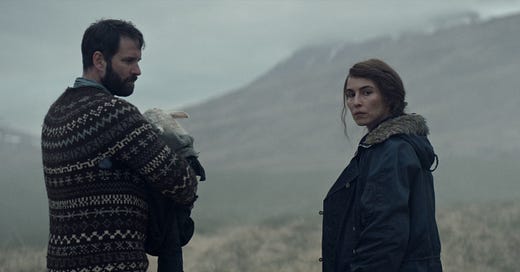At one point in Lamb—the latest iteration of folkloric horror distributed by the studio, A24, that brought us Midsommarand The Witch—a character takes stock of the situation in which he has found himself and asks “What the fuck is this?”
It’s hard to blame Pétur (Björn Hlynur Haraldsson) for his confusion, which borders on disgust. His brother Ingvar (Hilmir Snær Guðnason) and his brother’s wife, Maria (Noomi Rapace), are living with … well, a half-child, half-lamb. That’s it, that’s the only way to describe the surrogate that has entered the couple’s lives and brought them great happiness and a renewed sense of purpose.
But Pétur too is won over in due time by Ada, his confusion giving way to love, the girl’s innocent eyes warming his cold heart and allowing him to accept the mystery and answer his own question with “Sure, why not?” And I am curious to see how many viewers can get past “What the fuck is this?” to “Sure, why not?” Mostly because I’m not sure I quite wound up there myself.
Lamb features moments of great beauty, using the windswept hinterlands of Iceland to highlight the isolation felt by Maria and Ingvar and the loneliness they feel in their childless marriage. I love how director Valdimar Jóhannsson keeps his camera in the distance and lets us watch Rapace and Guðnason walk across the width of the widescreen, mountains looming in the distance. It feels like an alien landscape at times, the married couple pioneers on some distant planet cut off from humanity.
That tone of separation from the rest of the world is set early when, in a point-of-view shot, we trudge along with someone, or maybe something, as it traverses the countryside late on a Christmas night. We know it’s a POV shot because we can hear whatever it is, breathing, as it lurches along. The rare animal that comes by seems skittish at whatever this thing is, though the sheep in the barn seem pretty down. The feeling this shot gives is one of dislocation: in terms of space, sure, but also time. This whole shot feels as though it’s taken from another century, one sparsely populated with people and filled with demons.
But Maria and Ingvar live in modernity. They have a tractor with which they plant; a radio with which they listen to the news; a flat-screen TV that brings them handball games. The one real technological incongruity we see later, when a VCR is used, though this too contributes to a sense of time-out-of-place. And they live alone, doing the work the farm needs doing to ensure they have sheep to slaughter and plants to harvest. They don’t have time for the sadness that is obviously consuming them, a sadness summed up in the crib that rests in storage, the graveyard near the house bearing the name they wind up giving their lamb.
Maria and Ingvar’s life is simultaneously modern and ancient, unusual to those of us for whom farming is a foreign way of living, who have time to worry about if we’re a “bad art friend.” There is unhappiness here, but it’s the silent sort, the sort that’s not worth vocalizing. Why waste time complaining when the vast expanse of empty land will be silent to your pleas? Why waste energy wishing for things that cannot happen when there’s work to be done in the barn or in the field?
Pétur, with his leather clothes and rock-star attitude, adds a dash of modern sensibility to the setting when he arrives near the end of the first act; we see it in the way his brother has to roust him from bed and remind him that there’s work to be done. And it’s his modern skepticism we share when his first reaction to Ada is something like amused revulsion at the idea of playing house with an abomination. But you’d have to have a heart of stone not to be moved by the creature, and therein lies the trap, one sprung in the film’s closing moments.
(Note: a brief and vague discussion of the end follows the jump here, so consider yourself warned for mild spoilers.)
I won’t describe that finale here, except to say that I found it confoundingly literal in a way that I wasn’t quite expecting. There’s not much in the way of nuance or mystery, which has the weirdly counterintuitive effect of obscuring this modern folk fable’s message, and a fable without a message isn’t much of a fable. It was not precisely clear to me what we are supposed to learn from Maria and Ingvar’s decision to take Ada into their home, whether the price they pay for tampering with nature is earned or arbitrary.
As someone who quite likes down notes and being left on them, I don’t think the bummer of an ending is why Lamb left me cold. At least not entirely. Again, my issue here might just be how starkly literal the imagery was and how goofy that imagery struck me as being. But then, the whole thing is slightly goofy, and if the goofiness hadn’t bothered me up until that point, then I don’t think the problem is my ability to suspend disbelief.
Whatever the reason, the ending of Lamb didn’t really land for me, and that failure to bring it all home in a satisfying way undercuts the rest of the picture’s great beauty. I will be very curious to see how audiences react to it.





